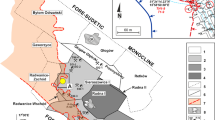Abstract
Based on the analyses and comparisons of water chemistry, stable carbon isotopes and deposition rates of speleothems, the authors found that there are two kinds of speleothems in the tunnels at the Wujiangdu Dam site, Guizhou, China, namely the CO2-outgassing type and the CO2-absorbing type. The former is natural, as observed in general karst caves, and the product of karst processes under natural conditions. The latter, however, is special, resulting from the carbonation of a cement-grouting curtain and concrete. Due to the quick absorption of CO2 from the surrounding atmosphere, evidenced by the low CO2 content in the air and the high deposition rate of speleothems (as high as 10 cm/a) in the tunnels, the contribution of the carbonation process to the sink of CO2 in the atmosphere is important (in the order of magnitude of 108 tons c/a) and should be taken into consideration in the study of the global carbon cycle because of the use of cement on a worldwide scale.
Similar content being viewed by others
Author information
Authors and Affiliations
Additional information
Received: 21 July 1997 · Accepted: 13 January 1997
Rights and permissions
About this article
Cite this article
Liu, Z., He, D. Special speleothems in cement-grouting tunnels and their implications of the atmospheric CO2 sink. Environmental Geology 35, 258–262 (1998). https://doi.org/10.1007/s002540050312
Issue Date:
DOI: https://doi.org/10.1007/s002540050312




